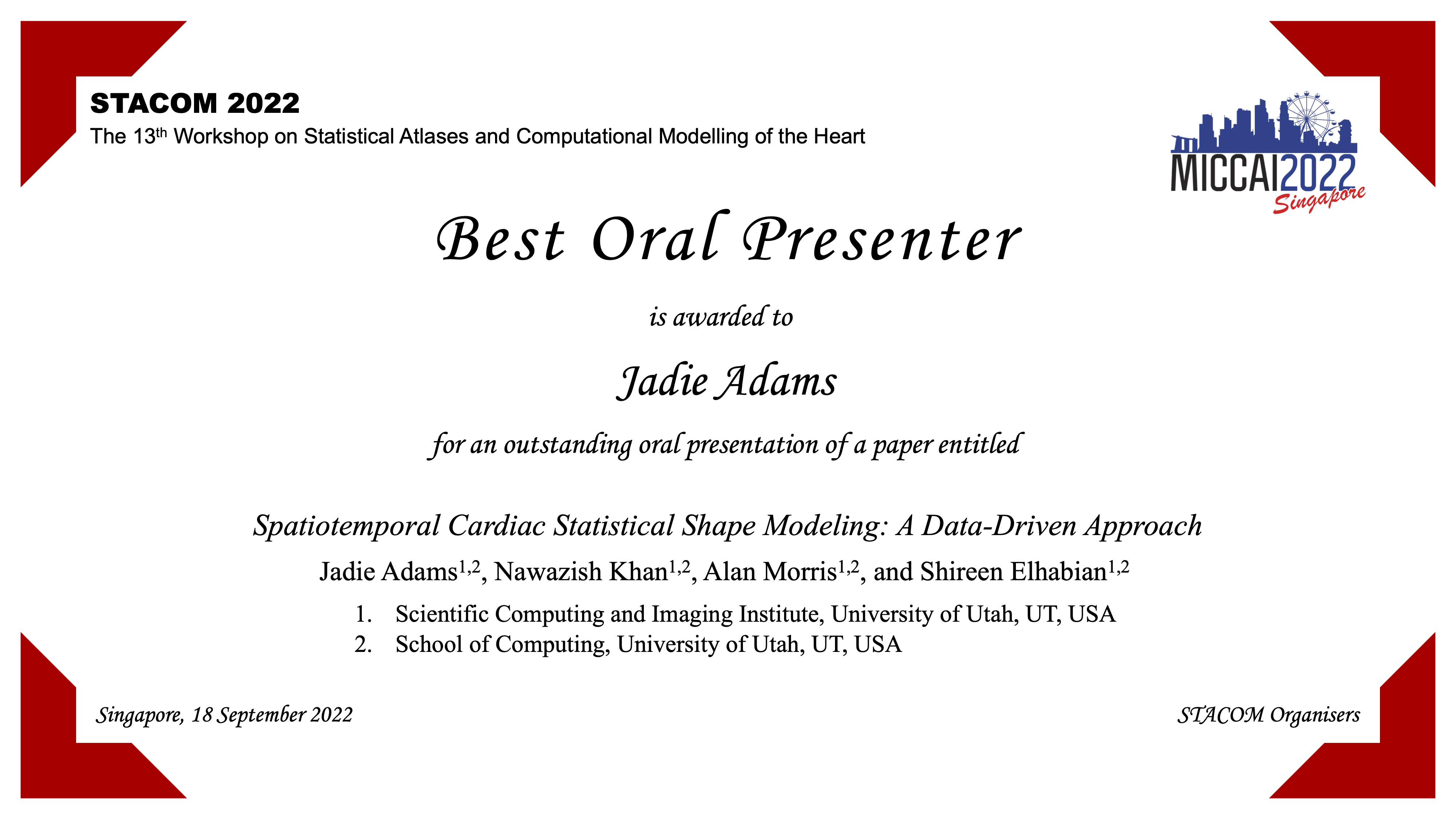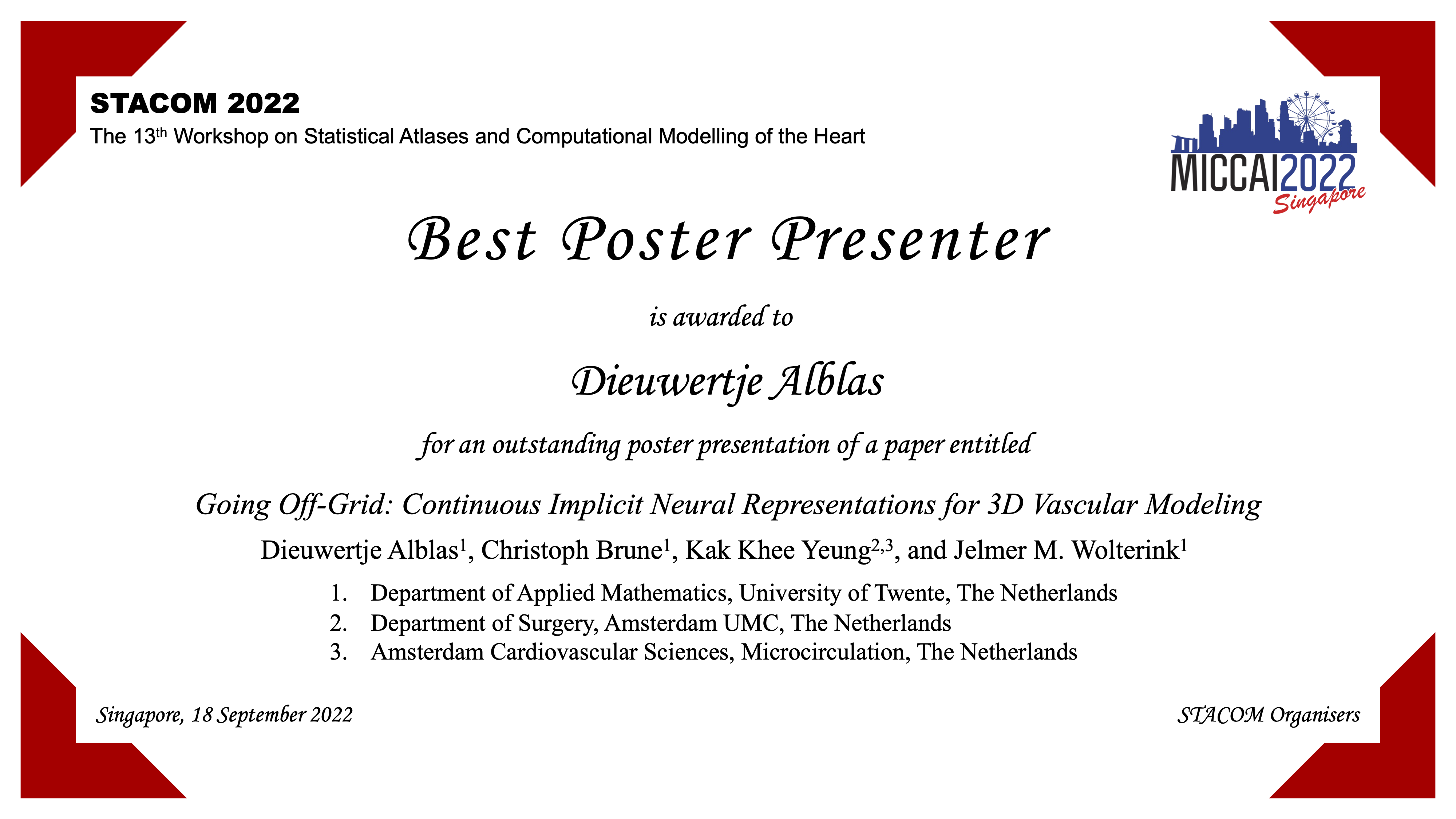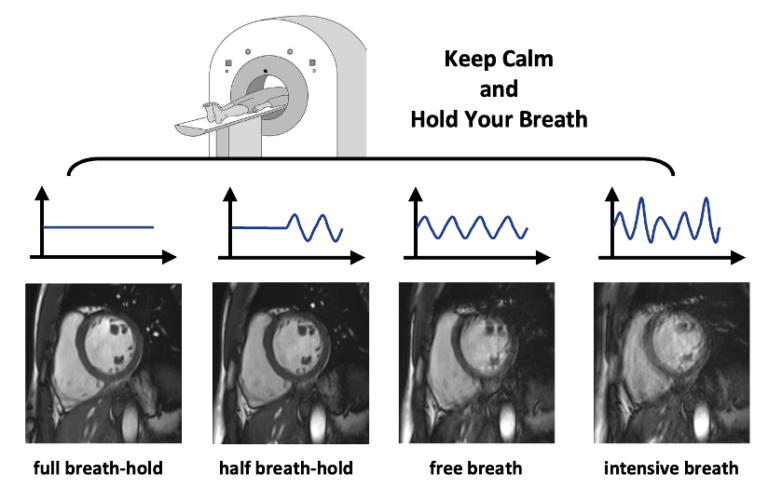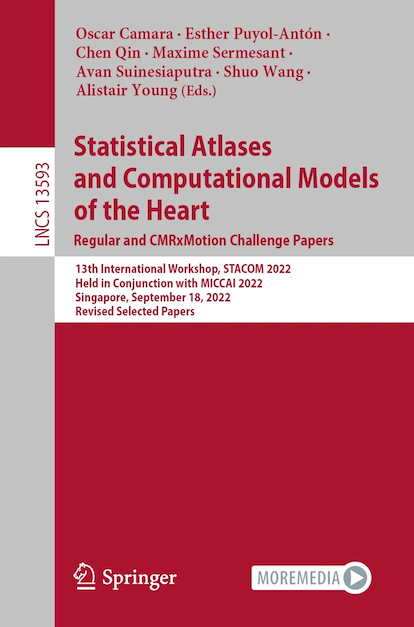The Statistical Atlases and Computational Modeling of the Heart (STACOM) workshop has been running annually at MICCAI since 2010. The 13th edition of STACOM workshop is going to be held in conjunction with the MICCAI 2022 in Singapore. The STACOM workshop is aiming to create a collaborative forum for young/senior researchers (engineers, biophysicists, mathematicians) and clinicians, working on: statistical analysis of cardiac morphology and dynamics, computational modelling of the heart and fluid dynamics, data/models sharing, personalisation of cardiac electro-mechanical models, quantitative image analysis and translational methods into clinical practice.
Awards
Congratulations to Jadie Adams from University of Utah, USA, for the best oral presenter award; and to Dieuwertje Alblas from University of Twente, the Netherlands, for the best poster presenter award.
| Best Oral Presenter | Best Poster Presenter |
|---|---|
 |
 |
Papers
In total, there are 34 papers accepted as regular papers, where 10 of them were presented as oral presentations. The CMRxMotion challenge accepted 14 papers, where the LAScarQS challenge accepted 16 papers.
Keynote speaker
INITIATE project - integrated computational modeling of right heart mechanics and blood flow dynamics in congenital heart disease
Liang Zhong
Associate Professor at National Heart Centre Singapore and Duke National University of Singapore
 Liang Zhong is an Associate Professor at National Heart Centre Singapore and Duke National University of Singapore. He is heading Cardiovascular Engineering and Technologies Theme and co leading Cardiovascular System AI Lab. His research focuses on cardiovascular imaging, computational modeling, cardiovascular mechanics and physiology, and application of artificial intelligence in medicine. He has developed methods for quantification of heart shape, myocardial velocity and strain, and function using MRI feature tracking and 4D flow MRI. He is Principal Investigator for 1) INITIATE project to identify the most useful imaging and circulating biomarkers and exercise testing to guide management of paediatric and adult congenital heart disease [ClinicalTrials: NCT03217240]; 2) APOLLO programme. A 5000 cohort of Singaporean will be established for the study of coronary calcium score, epicardial adipose tissue, stenosis, and plaque using AI algorithm and cardiovascular outcome. His work has been supported by National Research Foundation, National Medical Research Council, Biomedical Research Council, A*STAR, and SingHealth Foundation. He has published over 180 peer-reviewed papers and filed 10 patents.
Liang Zhong is an Associate Professor at National Heart Centre Singapore and Duke National University of Singapore. He is heading Cardiovascular Engineering and Technologies Theme and co leading Cardiovascular System AI Lab. His research focuses on cardiovascular imaging, computational modeling, cardiovascular mechanics and physiology, and application of artificial intelligence in medicine. He has developed methods for quantification of heart shape, myocardial velocity and strain, and function using MRI feature tracking and 4D flow MRI. He is Principal Investigator for 1) INITIATE project to identify the most useful imaging and circulating biomarkers and exercise testing to guide management of paediatric and adult congenital heart disease [ClinicalTrials: NCT03217240]; 2) APOLLO programme. A 5000 cohort of Singaporean will be established for the study of coronary calcium score, epicardial adipose tissue, stenosis, and plaque using AI algorithm and cardiovascular outcome. His work has been supported by National Research Foundation, National Medical Research Council, Biomedical Research Council, A*STAR, and SingHealth Foundation. He has published over 180 peer-reviewed papers and filed 10 patents.
Challenges
STACOM 2022 is running two exciting challenges:
CMRxMotion Challenge The Extreme Cardiac MRI Analysis Challenge under Respiratory Motion (CMRxMotion). The aim is to assess the effects of respiratory motion on CMR imaging quality and exam the robustness of automatic segmentation models under different four levels of respiratory motion: full breath-hold, half breath-hold, free breathing, and intensive breathing. For training, images from 30 volunteers (120 cases) will be released together with quality scores and ground-truth segmentations. Images from another 30 volunteers (120 cases) will be withheld for the challenge benchmarking. There are two tasks: 1) detection of images with non-diagnostic quality, and 2) automated segmentation that robust to respiratory motion artefacts. The Extreme Cardiac MRI Analysis Challenge under Respiratory Motion (CMRxMotion). The aim is to assess the effects of respiratory motion on CMR imaging quality and exam the robustness of automatic segmentation models under different four levels of respiratory motion: full breath-hold, half breath-hold, free breathing, and intensive breathing. For training, images from 30 volunteers (120 cases) will be released together with quality scores and ground-truth segmentations. Images from another 30 volunteers (120 cases) will be withheld for the challenge benchmarking. There are two tasks: 1) detection of images with non-diagnostic quality, and 2) automated segmentation that robust to respiratory motion artefacts.click here for more CMRxMotion challenge information |
LAScarQS 2022 Left Atrial and Scar Quantification & Segmentation Challenge (LAScarQS 2022). The Challenge provides >200 LGE MRIs acquired in real clinical environment from patients suffering atrial fibrillation (AF). Your task is to (semi-)automatically segment LA cavity and quantify LA scars from LGE MRI. The challenge presents an open and fair platform for various research groups to test and validate their methods on these datasets acquired from the clinical environment. To ensure data privacy, the platform will enable remote training and testing on the dataset from different centers in local and the dataset can keep invisible. Left Atrial and Scar Quantification & Segmentation Challenge (LAScarQS 2022). The Challenge provides >200 LGE MRIs acquired in real clinical environment from patients suffering atrial fibrillation (AF). Your task is to (semi-)automatically segment LA cavity and quantify LA scars from LGE MRI. The challenge presents an open and fair platform for various research groups to test and validate their methods on these datasets acquired from the clinical environment. To ensure data privacy, the platform will enable remote training and testing on the dataset from different centers in local and the dataset can keep invisible.click here for more LAScarQS challenge information |

